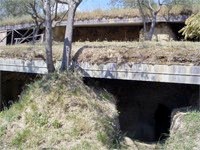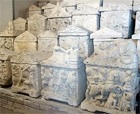
This vast necropolis is just outside Ponte San Giovanni, about 6 kilometres southeast of Perugia, on a slope that descends to the Tiber. The area is named for the Villa del Palazzone, which belonged to the Baglioni family. A few Etruscan hypogea were discovered here in the 1790s, but interest in the site intensified when the amazing Ipogeo dei Volumni was unearthed during roadworks in February 1840. Subsequent excavations sponsored by Count Benedetto Baglioni and his neighbours established the fact that this hypogeum was on the edge of a large necropolis. The necropolis, which had been in use over a number of centuries, seems to have fallen out of use at about the time of the Perusine War (40 BC).
The excavation of the area was fashionable among the intellectuals of Perugia throughout the following decade. For example, Crown Prince Ludwig of Bavaria attended the opening of the Ipogeo dei Cacni when it was discovered in 1844. However, these well-meaning men were not trained archeologists and much of their work was undocumented. Giovanni Battista Vermiglioli, the uncle of the wife of Benedetto Baglioni, did commit some of the work to paper, but he was approaching the end of his life. His follower, Giovanni Carlo Conestabile della Staffa catalogued some 38 hypogea that had been discovered by 1855. Nevertheless, the original provenance of most of the funerary urns and grave goods was lost and many of the artefacts themselves were dispersed. The area was then largely neglected until 1963, when systematic excavation revealed some 200 hypogea that were cut into the rock.
Some of the grave goods from the site are exhibited in the Antiquarium del Palazzone, while others are now in the Museo Archeologico.
Archaic Hypogea (late 6th and 5th centuries)
Five of the hypogea excavated to date are much older than the rest. The richest of these were discovered in 1843, close to each other at the top of the hill behind the Ipogeo dei Volumni:
-
✴the Ipogeo dei Cafate; and
-
✴the Ipogeo degli Acsi.
Each comprised an entrance hall (dromos) with five rooms off it (one at the back and two to each side).
-
✴Most of the surviving grave goods from these hypogea are now in the Museo Archeologico.
-
✴A red-figured vase (330 – 310 BC) that is documented, probably inaccurately, as coming from Ipogeo degli Acsi is now in the Antiquarium del Palazzone.
Hellenistic Hypogea (4th - 1st centuries BC)
The great majority of the hypogea belong to the Hellenistic period . Most of them (with the conspicuous exception of the Ipogeo dei Volumni) were simple chambers hewn out of the rock, although some contained more than one chamber.


The complex: Palazzone Necropolis Ipogeo dei Volumni Antiquarium del Palazzone.
Return to Museums of Perugia.
Return to Excursions from Perugia.



